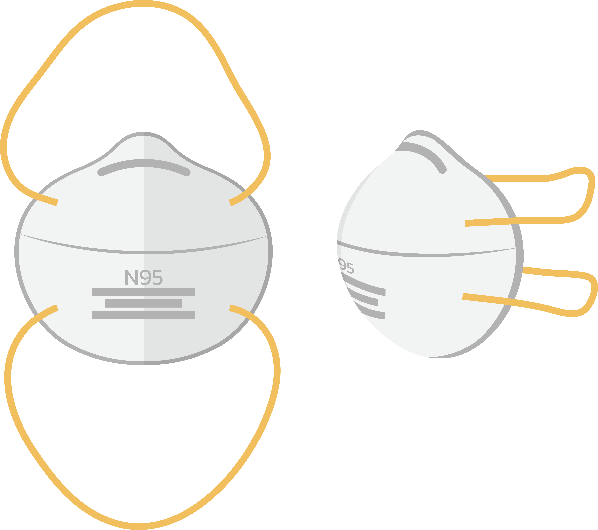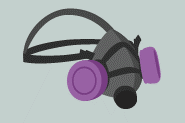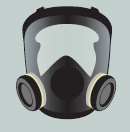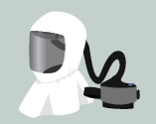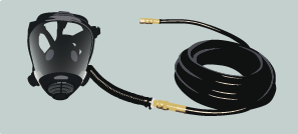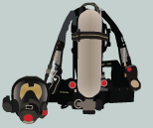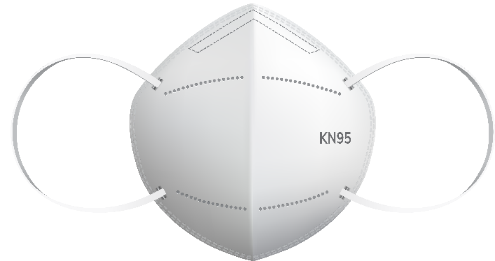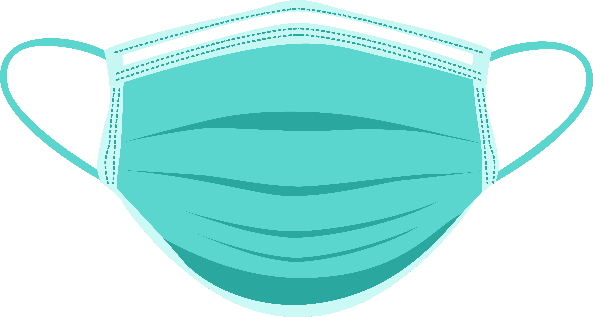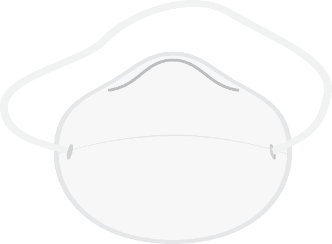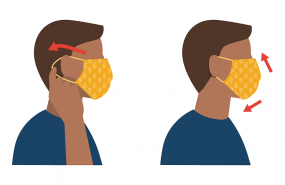SRUP ICDF Survey of Respirator Use and Practices
Survey of Respirator Use and Practices
SRUP survey questions for OMB 20210813
OMB: 1220-0171
2022 Survey of Respirator Use and Practices Questions - FINAL
Dear Employer,
The Survey of Respirator Use and Practices (SRUP) will help the U.S. Bureau of Labor Statistics (BLS) and the National Institute for Occupation Safety and Health (NIOSH) understand how employees are using respirators and other devices in businesses across the U.S.
This survey will cover the use of the following devices:
NIOSH-Approved respirators, which we’ll refer to as “respirators,” include:
NIOSH-Approved Filtering Facepiece Respirators (FFRs) (e.g., N95, P100)
Elastomeric Half-Mask or Full Facepiece Air-Purifying Respirators
Powered Air-Purifying Respirators (PAPRs)
Supplied-Air Respirators
Self-Contained Breathing Apparatus (SCBAs)
Other devices (Non-NIOSH approved respirators and other face coverings), which we’ll refer to as “masks,” include:
Non-NIOSH Approved Emergency Use International Respirators (e.g., KN95)
Surgical Masks (medical grade, Food and Drug Administration (FDA) approved)
Dust Masks (non-medical, not FDA approved)
All other non-medical masks or face coverings including cloth masks, disposable masks, gaiters, etc.
What information will I need?
The survey will cover the use of respirators and masks at your business. We will be asking about the number of employees, the number using respirators and masks, and other topics related to your respiratory protection program. It may be helpful to have all the information gathered before you start the survey. You can find a PDF version of the survey on the respondent website. Once you start, if you find you need more information, you can save your data and complete the survey later.
If you have questions about completing this survey, please call (555-555-5555) or email ([email protected]). For website technical help only, click on the Help Request Form.
See our Frequently Asked Questions to familiarize yourself with features of this site.
Establishment Location Information
Report
for: Unit Description
Primary Company Name
Secondary Company Name
Address
Line 1
Address Line 2
City, State, Zip+four
Instructions: Complete this survey about the use of respiratory devices and masks at the location(s) listed above. If you have other locations, only include about the location(s) listed above.
Are you able to provide information on respirator and mask usage on the location(s) exactly as listed above?
Yes, I can report for the location(s) as listed [skip to question 2]
No, I cannot report for the location(s) as listed [go to question 1a]
1a. Are you able to report any information about the location(s) listed above?
Yes, but only with other locations that are not listed [skip to question 2, with instructions on a separate page saying “Please complete the survey, providing data combined across the location listed and the other locations.”]
Yes, but only for part of the location listed [skip to question 2, with instructions on a separate page saying “Please complete the survey, providing data from the portion of the location listed you are able to report on.”]
No, I am not able to report any data for the location(s) listed [go to question 1b]
1b. Why are you unable to report about the location(s) listed above? [skip to Data Review screen and submit survey]
The location(s) are out of business
The location(s) are not for this business, or are unfamiliar
Some other reason
2. How many people are currently employed at this location?
Include:
Full-time and Part-time employees
Employees who are contracted to work at other locations for other companies
Temporary and Seasonal employees
Do not include:
Contract or sub-contract employees
3. How many people were employed at this location as of March 1, 2020, prior to the COVID-19 pandemic?
Include:
Full-time and Part-time employees
Employees who are contracted to work at other locations for other companies
Temporary or Seasonal employees
Do not include:
Contract or sub-contract employees
Definitions
This is a survey to obtain information about the use of respirators and masks in U.S. businesses.
Please review the list below. Please note that N95 respirators are different from surgical masks, although they have often been used for the same purpose during the COVID-19 pandemic.
NIOSH-Approved Respirators (referred to as “Respirators”) |
|
NIOSH-Approved Filtering Facepiece Respirators (FFRs) (e.g., N95, P100)
FFRs are disposable half facepiece respirators that filter out particles such as dusts, mists, and fumes. They do NOT provide protection against gases and vapors.
Includes a NIOSH-Approved label and has two head straps |
|
Elastomeric Half-Mask or Full Facepiece Air-Purifying Respirators
Elastomeric respirators are reusable and have replaceable cartridges or filters. They provide protection against gases, vapors, or particles when equipped with the appropriate cartridge or filter. |
|
Powered Air-Purifying Respirators (PAPRs)
PAPRs have a battery-powered blower that pulls air through attached filters, canisters, or cartridges. They provide protection against gases, vapors, or particles, when equipped with the appropriate cartridge, canister, or filter. Loose-fitting PAPRs do not require fit testing and can be used with facial hair |
|
Supplied-Air Respirators
Supplied-air respirators are connected to a separate source that supplies clean compressed air through a hose. They can be lightweight and used while working for long hours in environments not immediately dangerous to life and health (IDLH). |
|
Self-Contained Breathing Apparatus (SCBAs)
SCBA’s are used for entry into or escape from environments considered to be IDLH. They contain their own breathing air supply and can be either open circuit or closed circuit. |
|
Other Devices (Non-NIOSH Approved Respirators and Masks/Coverings) (referred to as “Masks”) |
|
Non-NIOSH Approved Emergency Use International Respirators (e.g., KN95)
Includes two earlobe straps. |
|
Surgical Masks (medical grade, FDA-approved)
Includes two earlobe straps. |
|
Dust Masks (not medical grade, not FDA-approved)
Includes one head strap. |
|
All other non-medical masks or face coverings including cloth masks, disposable masks, gaiters, etc.
|
|
We would like to know about respirator and mask usage at this location.
4. Have employees at this location used any of the following devices since March 1, 2020?
For respirators, include all devices that employees have been qualified to wear (fit tested and/or trained). For FFRs (such as N95s and P100s), include all employees who have worn a device.
For masks, include all devices that employees have worn.
-
Yes
No
Don’t Know
Respirators
NIOSH-Approved Filtering Facepiece Respirators (FFRs) (e.g., N95, P100)
Elastomeric Half-Mask or Full Facepiece Air-Purifying Respirators
Powered Air-Purifying Respirators (PAPRs)
Supplied-Air Respirators
Self-Contained Breathing Apparatus (SCBAs)
Other:
Masks
Non-NIOSH Approved Emergency Use International Respirators (e.g., KN95)
Surgical Masks
Dust Masks
All other non-medical masks or face coverings including cloth masks, disposable masks, gaiters, etc.
[Note: going forward for all questions that have the grid with respirators and/or masks (except where noted), only respirators and masks that are selected ‘Yes’ in question 4 should be displayed for each question. Right now all respirator and masks are listed for most questions. Question 4 is designed to be a screener question and reduce burden if the respondent has not used certain respirators or masks since March 1, 2020.]
If at least one row in question 4 has a “Yes” response, continue to question 5.
If a respondent answers No or Don’t know for all rows in question 4, then they go to the Data Review screen and submit the survey.
5. How do employees at this location currently use respirators and masks? (Select all that apply)
Voluntary Use: Employee decides to use the respirator or mask (with the employer’s approval) for personal reasons (e.g., allergy, desire to reduce exposure beyond that required by regulation, etc.).
Required Non-Emergency Use: Respirator or mask use for exposure to known substances which is required by regulation or by the employer.
Required Emergency Use: Respirator or mask use as a result of an unplanned situation, including escape from or entry into a potentially hazardous environment.
-
Voluntary Use
Required Non-Emergency Use
Required Emergency Use
Don’t know
Respirators
NIOSH-Approved Filtering Facepiece Respirators (FFRs) (e.g., N95, P100)
Elastomeric Half-Mask or Full Facepiece Air-Purifying Respirators
Powered Air-Purifying Respirators (PAPRs)
Supplied-Air Respirators
Self-Contained Breathing Apparatus (SCBAs)
Other:
Masks
Non-NIOSH Approved Emergency Use International Respirators (e.g., KN95)
Surgical Masks
Dust Masks
All other non-medical masks or face coverings including cloth masks, disposable masks, gaiters, etc.
Transition screen: The next few questions will ask about the use of respirators and masks before and during the COVID-19 pandemic, and current use at this location listed at the beginning of the survey.
6. How many employees at this location used each of the following respirators and masks for the time frames listed below?
If employees wore multiple types of devices, include them in the count for each kind they wore.
For respirators, include all employees who are qualified to wear them (fit tested and/or trained). For FFRs (such as N95s and P100s), include all employees who have worn a device.
For masks, include all employees who wear or wore them.
|
Pre-COVID-19
Number of Employees who used the device as of March 1, 2020, prior to the COVID-19 pandemic |
Maximum During COVID-19
Maximum number of employees who used the device at any given time from March 15, 2020 to March 15, 2021 |
Currently
Number of Employees who currently use the device |
Respirators |
|
|
|
NIOSH-Approved Filtering Facepiece Respirators (FFRs) (e.g., N95, P100) |
|
|
|
Elastomeric Half-Mask or Full Facepiece Air-Purifying Respirators |
|
|
|
Powered Air-Purifying Respirators (PAPRs) |
|
|
|
Supplied-Air Respirators |
|
|
|
Self-Contained Breathing Apparatus (SCBAs) |
|
|
|
Other: |
|
|
|
Masks |
|
|
|
Non-NIOSH Approved Emergency Use International Respirators (e.g., KN95) |
|
|
|
Surgical Masks |
|
|
|
Dust Masks |
|
|
|
All other non-medical masks or face coverings including cloth masks, disposable masks, gaiters, etc. |
|
|
|
7. Did you experience a shortage of respirators during the COVID-19 pandemic at this location?
A shortage is defined as a difficulty in obtaining respirators or an actual shortage of supply.
All 7 rows will be displayed in the chart below regardless of the responses provided in the screener question 4.
-
Yes
No
Don’t Know
NIOSH-Approved Filtering Facepiece Respirators (FFRs) (e.g., N95, P100)
Elastomeric Half-Mask or Full Facepiece Air-Purifying Respirators
Powered Air-Purifying Respirators (PAPRs)
Supplied-Air Respirators
Self-Contained Breathing Apparatus (SCBAs)
Non-NIOSH Approved Emergency Use International Respirators (e.g., KN95)
Filters, cartridges, and other respirator supplies
8. Which of the substances listed below have been potential airborne hazards at this location in the last 12 months?
Include hazardous substances that could possibly be present above the OSHA Permissible Exposure Limits (PEL) or American Conference of Governmental Industrial Hygienists (ACGIH) Threshold Limit Values (TLV) even if they are controlled through mechanical ventilation or some other viable control mechanism. (Select all that apply)
Gas or Vapor
|
Particulate
|
Both Gas/Vapor and Particulate
Other
|
Occupation questions
Transition screen: This section will address respirator and mask usage by occupation.
9. Do you currently have any employees in the occupations listed below at this location?
[This list will be populated with up to 14 occupations and their definitions based on the NAICS code for this location]
-
Occupation
Yes
No
Don’t know
Occupation 1
Occupation 2
Occupation 3
Occupation 4
Occupation 5
Occupation 6
…
Occupation 14
If at least one occupation is selected as “Yes”, then go to question 10.
If all 14 occupations are “No” or “Don’t know”, then go to question 9a and display a second list of occupations.
10. Do employees in these occupations at this location currently use respirators or masks?
-
Occupation
Yes, Both Respirators and Masks
Yes, Respirators Only
Yes, Masks Only
No
Don’t know
List only occupations marked “Yes” in the question 9.
If there is at least one occupation that is selected as “Yes, Both Respirators and Masks” or “Yes, Respirators Only”, then these occupations should be given the first priority of selection.
If there is only one occupation that is selected as “Yes, Both Respirators and Masks” or “Yes, Respirators Only”, then that occupation will be selected to continue with the remaining occupation questions. Skip to the transition screen before question 11.
If more than one occupation is selected as “Yes, Both Respirators and Masks” or “Yes, Respirators Only”, then sort all those occupations with one of these two responses by the random number and select the occupation with the smallest random number to continue with the remaining occupation questions. Skip to the transition screen before question 11.
If there are no occupations that are selected as “Yes, Both Respirators and Masks” or “Yes, Respirators Only”, but there is at least one occupation that is selected as “Yes, Masks Only”, then these occupations should be given second priority of selection.
If there is only one occupation that is selected as “Yes, Masks Only”, then that occupation will be selected to continue with the remaining occupation questions. Skip to the transition screen before question 11.
If more than one occupation is selected as “Yes, Masks Only”, then sort all those occupations with this response by the random number and select the occupation with the smallest random number to continue with the remaining occupation questions. Skip to the transition screen before question 11.
If there are no occupations that are selected as “Yes, Both Respirators and Masks”, “Yes, Respirators Only”, or “Yes, Masks Only”, then go to question 9a and display the second list of occupations for the respondent.
9a. Do you currently have any employees in the occupations listed below at this location?
[This list will be populated with up to 10 occupations and their definitions based on the NAICS code for this location]
-
Occupation
Yes
No
Don’t know
Occupation 1
Occupation 2
Occupation 3
Occupation 4
Occupation 5
Occupation 6
…
Occupation 10
If at least one occupation is selected as “Yes”, then go to question 10a.
If all 10 occupations are “No” or “Don’t know”, then check to see if any rows for respirators in question 4 have a “Yes” response selected.
If no respirator rows have a “Yes” response in question 4, then go to the Data Review screen and submit the survey.
If at least one row for respirators has a “yes” response in questions 4, then go to the transition screen before question 16 (start of Fit testing section.)
10a. Do employees in these occupations at this location currently use respirators or masks?
-
Occupation
Yes, Both Respirators and Masks
Yes, Respirators Only
Yes, Masks Only
No
Don’t know
List only occupations marked “Yes” in the question 9a.
If there is at least one occupation that is selected as “Yes, Both Respirators and Masks” or “Yes, Respirators Only”, then these occupations should be given the first priority of selection.
If there is only one occupation that is selected as “Yes, Both Respirators and Masks” or “Yes, Respirators Only”, then that occupation will be selected to continue with the remaining occupation questions. Skip to the transition screen before question 11.
If more than one occupation is selected as “Yes, Both Respirators and Masks” or “Yes, Respirators Only”, then sort all those occupations with one of these two responses by the random number and select the occupation with the smallest random number to continue with the remaining occupation questions. Skip to the transition screen before question 11.
If there are no occupations that are selected as “Yes, Both Respirators and Masks” or “Yes, Respirators Only”, but there is at least one occupation that is selected as “Yes, Masks Only”, then these occupations should be given second priority of selection.
If there is only one occupation that is selected as “Yes, Masks Only”, then that occupation will be selected to continue with the remaining occupation questions. Skip to the transition screen before question 11.
If more than one occupation is selected as “Yes, Masks Only”, then sort all those occupations with this response by the random number and select the occupation with the smallest random number to continue with the remaining occupation questions. Skip to the transition screen before question 11.
If there are no occupations that are selected as “Yes, Both Respirators and Masks”, “Yes, Respirators Only”, or “Yes, Masks Only”, then check if any rows in the “Number of employees who currently use the device” column in question 6 have a positive number of employees entered?
If yes, then go to the transition screen and then go to the transition screen before question 16.
If no, then skip to the Data Review screen and submit the survey.
For the occupation questions below that have <fill>, use the full occupation title exactly as listed in Q9 or Q9a that was randomly selected.
Transition screen: The next few questions will ask about respirator and mask usage for the occupation <fill>. Please provide responses for just that occupation.
11. How many employees currently work in the occupation <fill> at this location?
12. How many employees for the occupation <fill> are currently using the following types of respirators or masks at this location?
If employees wore multiple types of devices, include them in the count for each kind they wore.
For respirators, include all employees who are qualified to wear them (fit tested and/or trained). For FFRs (such as N95s and P100s), include all employees who have worn a device.
For masks, include all employees who wear or wore them.
-
Number of Employees in this occupation who currently use the device
Respirators
NIOSH-Approved Filtering Facepiece Respirators (FFRs) (e.g., N95, P100)
Elastomeric Half-Mask or Full Facepiece Air-Purifying Respirators
Powered Air-Purifying Respirators (PAPRs)
Supplied-Air Respirators
Self-Contained Breathing Apparatus (SCBAs)
Masks
Non-NIOSH Approved Emergency Use International Respirators (e.g., KN95)
Surgical Masks
Dust Masks
All other non-medical masks or face coverings including cloth masks, disposable masks, gaiters, etc.
13. Why do employees in this occupation <fill> currently use respirators or masks at this location? (Select all that apply)
Only include the rows that have a positive number of employees entered for question 12 in the chart below.
|
Used to protect against work-related hazards |
Used to protect against coronavirus |
Don’t know |
Respirators |
|
|
|
NIOSH-Approved Filtering Facepiece Respirators (FFRs) (e.g., N95, P100) |
|
|
|
Elastomeric Half-Mask or Full Facepiece Air-Purifying Respirators |
|
|
|
Powered Air-Purifying Respirators (PAPRs) |
|
|
|
Supplied-Air Respirators |
|
|
|
Self-Contained Breathing Apparatus (SCBAs) |
|
|
|
Masks |
|
|
|
Non-NIOSH Approved Emergency Use International Respirators (e.g., KN95) |
|
|
|
Surgical Masks |
|
|
|
Dust Masks |
|
|
|
All other non-medical masks or face coverings including cloth masks, disposable masks, gaiters, etc. |
|
|
|
Are there rows that have a positive number of employees entered for question 12 and have selected “Used to protect against work-related hazards” in question 13?
If yes, then check if question 5 has more than one column selected (out of the first 3) for any row.
If yes, then go to question 14.
If no, then go to question 15. On the back end we will fill in the response for the establishment in question 5 when only one column is answered and estimate that for the selected occupation in question 14. There is no need to ask the respondent question 14 for this situation.
If no, then check if any rows for respirators in question 4 have a “Yes” response.
If yes, then go to the transition screen before the fit testing section.
If no, then go to the Data Review screen and submit the survey.
14. How do employees in the occupation <fill> currently use respirators and masks to protect against work-related hazards at this location? (Select all that apply)
Voluntary Use: Employee decides to use respirator or mask (with the employer’s approval) for personal reasons (e.g., allergy, desire to reduce exposure beyond that required by regulation, etc.).
Required Non-Emergency Use: Respirator or mask use for exposure to known substances which is required by regulation or by the employer.
Required Emergency Use: Respirator or mask use as a result of an unplanned situation, including escape from or entry into a potentially hazardous environment.
-
Voluntary Use
Required Non-Emergency Use
Required Emergency Use
Don’t know
List of respirators and masks used for work-related hazards in Q13
15. In the last 12 months, what percentage of their time did employees in occupation <fill> wear respirators to protect against work-related hazards?
|
Rarely |
Occasionally |
Sometimes |
Often |
Usage Varies |
Don’t Know |
|
Up to 2% of their time |
2% up to 33% of their time |
33% up to 67% of their time |
67% or more of their time |
|
|
List of respirators used for work-related hazards in Q13 |
|
|
|
|
|
|
Transition screen: The next sections will address questions regarding your respirator program for ALL employees at this location.
Fit Testing
16. Are employees who wear respirators at this location fit tested prior to using respirators?
Yes, all are fit tested (continue to question 17)
Yes, some are fit tested (continue to question 17)
No (skip to question 19)
Don’t know (skip to question 19)
17. Which of the following methods do you currently use to assess your employees’ medical fitness to wear respirators at this location?
No medical fitness assessment
Questionnaire only
Questionnaire with follow-up exam required
Questionnaire with follow-up exam as needed
Medical exam only
Other—please list:
Don’t know
18. Who currently conducts the fit testing of the respirators at this location? (Select all that apply)
The respirator program manager or other health and safety expert
Medical personnel
A supervisor
A designated employee other than those listed above.
A respirator manufacturer sales/technical representative
Another external consultant or third-party company
Other—please list:
Training
19. Is respirator training currently provided to your employees who wear respirators at this location?
Yes (continue to question 20)
No (skip to question 23)
Don’t know (skip to question 23)
20. When is respirator training currently provided to employees who wear respirators at this location? (Select all that apply)
When the employee starts at the company
Annually
Other frequency (please specify):
Don’t know
21. How is respirator training currently provided to employees at this location? (Select all that apply)
Classroom training (real time, in-person or remote)
One-on-one training (real time, in-person or remote)
Online training (pre-recorded videos and materials)
Other, please specify:
Don’t know
22. Who currently provides the respirator training at this location? (Select all that apply)
The respirator program manager or other health and safety expert
Medical personnel
A supervisor
A designated employee other than those listed above.
A respirator manufacturer sales/technical representative
Another external consultant or third-party company
Other—please list:
23. What kinds of challenges do you face in carrying out your respiratory protection program?
24. What challenges do your employees face in the effective use of respirators?
25. What topics would you like more guidance and resources from NIOSH about?
| File Type | application/vnd.openxmlformats-officedocument.wordprocessingml.document |
| Author | VanHorn, Struther - BLS |
| File Modified | 0000-00-00 |
| File Created | 2022-05-08 |
© 2025 OMB.report | Privacy Policy
